

| Nottinghamshire's most recent invertebrate arrivals and colonists |
| No 3. Harvestmen |
| ... |
| Its not always the entomologists who have the fun and excitement of discovering of new county species, or even a first for the UK. Anything is possible and even arachnologists have their chance to get in on the act from time to time and find new species. |
| ... |
|
So if you need examples, well there are four
here in the form of Harvestmen (Opiliones) all of which have been added
to the VC56 Nottinghamshire species list within the past couple of
decades. Being far less recorded than many other invertebrate Orders, often means that finding a new Harvestmen for the county is not as unlikely as it may sound. And thanks to the importation of plants, timber and other goods from around the world, there's more than just a chance of several new species being found here. |
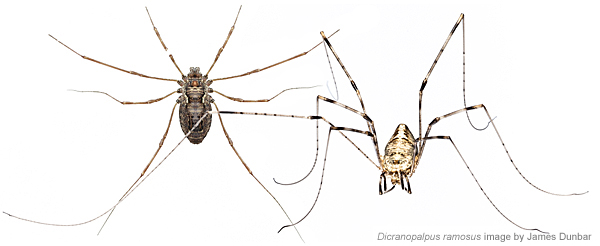 |
|
| .... | ||
|
What next for Nottinghamshire? The next most likely Nottinghamshire addition would be the confirmation of Dicranopalpus caudatus (Dresco, 1948). This has recently been seperated from the once easy to identify Dicranopalpus ramosus (Simon, 1909) after recent research by Hay Wijnhoven and Carlos E. Prieto, ended with the revalidation of Dicranopalpus caudatus to seperate species level once again. Visually identical to D. ramosus, microscopic examination of the male penis is required to determine species with certainty. But here's the three most likely species to turn up in Nottinghamshire, based purely on the fact that they are all in the UK already. |
|
| But there's
little need to watch and wait for species moving north through the
UK to turn up. Several species such as
Platybunus pinetorum
(C.L.Koch, 1839)
and
Leiobunum sp.A are both Harvestmen with their UK roots
entrenched firmly in the north, most especially
Leiobunum
sp.A, we found new to the UK on the wall of a Worksop terraced house.
But there are others and as with all invertebrates, it pays to never rule anything out. Never underestimate the possibility of something new to your county turning up almost literally at your front door. Most Harvestmen found new to the UK in recent years, have all come from urban location and often close to the finders homes. Its part of the joy and attraction of recording invertebrates and is a positive side to the role climate change has on Nottinghamshire's invertebrate fauna. Its an ever-changing process of gains and losses and we'll just have to accept the losses ultimately. Species summaries and distribution In the following species distribution maps, the locations of each species' first Nottingshire record is circled in red. First county records are more likely to appear local to the recorder, hence why the following four recent arrivals, all have their first records in the north of the county rather than the south. |
|
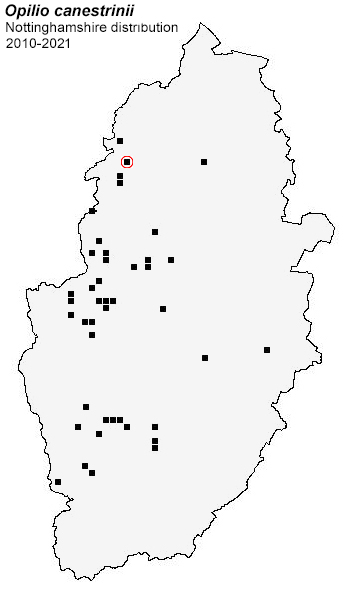 |
||||||
| ... | |||||||
| Nottinghamshire's second record was the only one in 2011, when a single specimen was recorded from the walls of the old Sherwood Forest Visitor Centre (Pendleton, T.A. and Pendleton, D.T.). There was an increase in the number of records during 2012, with a record from a Nottingham garden on Ward Avenue, Mapperley and further records from Worksop, at both Ridgeway (again) and nearby Worksop Priory (Pendleton, T.A. and Pendleton, D.T.). |
| ... |
|
Habitat: In our experience, Opilio canestrinii is a Harvestman of urban and suburban areas, where it is usually found on the walls of houses and other buildings. It seems fairly common in churchyards, in which instances, it is beaten from the branches of Yew Taxus baccata. There are just three records from rural sites at Sherwood Forest CP, Lambley Cemetery and Netherfield Lagoons. Latest known distribution (to March 2021): Has soon become a common Harvestman since the county's first record and is becoming increasingly more widespread. There is currently, just a single record (from Newark) east of the Trent Valley, where it must be considerably under-recorded. The main areas of distribution are around Nottingham, including all suburban areas and the city's public parks. It is found widely in the same sites across the Mansfield, Ollerton and Worksop areas. Adult season: Adults occur from Summer and continue to be found well into the Winter months, depending on the severity of the weather Identification: A large and long-legged Harvestman, easily identified by the orange coxa and trochanter (the two leg joints nearest the body) which no other UK Harvestman has. |
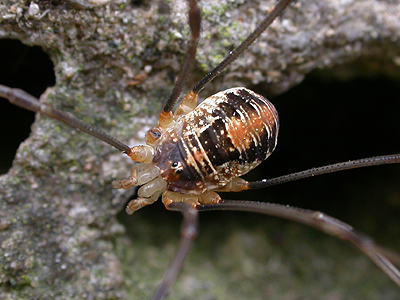 |
|
| ... | ||
| The body often has some degree of underlying orange hue or colouration to it and some specimens can be beautifully marked and very striking, as per the individual in the above right photograph. | ||
|
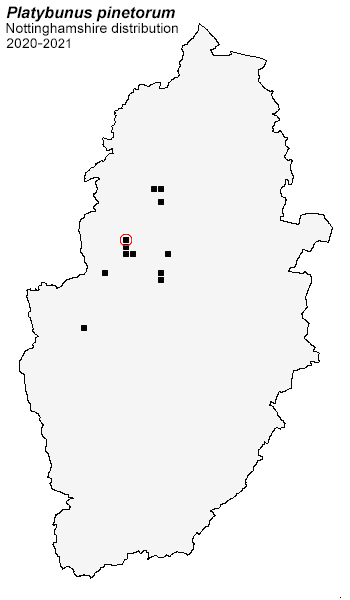 |
||||||
| ... | |||||||
|
Latest known distribution (to March 2021): Currently just the one Nottinghamshire record, but must obviously have a wider range in Nottinghamshire. The second county record could occur anywhere, but in view of its general north-westerly UK range, perhaps woodland or possibly even a suburban garden in west or north-west Nottinghamshire would be most favoured. Adult season: One of only a few purely Spring Harvestmen. Overwinter's as a juvenile/sub-adult and is adult from March to May and robably into June. Virtually all UK records of Platybunus pinetorum have referred to females, although a male was found in Yorkshire in 2020. Identification: Although very similar at first glance to Platybunus triangularis, to the experienced observer Platybunus pinetorum will be obvious almost immediately. It is a noticably darker species overall and the rich brown colour of the ocularium between the raised eyes is distinctive even at a few metres distance. |
|||||||
|
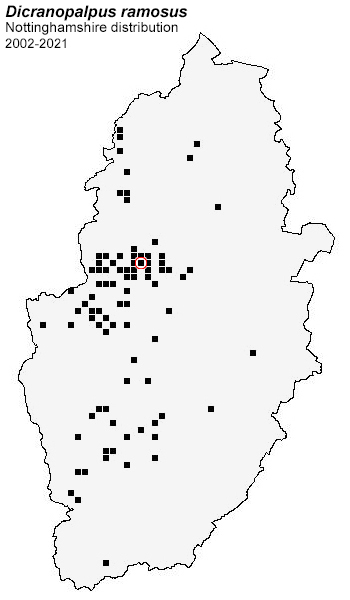 |
||||||
| ... | |||||||
|
Latest known distribution (to March 2021): This is now one of our most widespread Harvestmen. Despite the distribution map showing a records concentrated around Nottingham and Mansfield, it is probably the most likely Harvestman to occur at any site. Adult season: Adults are found from late Summer and through the Autumn to November, but there are numerous Winter records from December and January. The latest is of a female on a wall at a site in Mansfield on 16/02/16, which seems to be exceptionally late based on the records recieved. Identification: The unique position of the legs held at rest, has for many years, meant that this was always one of the easiest species to identify. Dicranopalpus ramosus rests with all eight legs held at right angles to the body in a very distinctive manner. However, recent research by Hay Wijnhoven and Carlos E. Prieto, has led to potential identification difficulties following the revalidation of Dicranopalpus caudatus (Dresco, 1948) as a seperate species. |
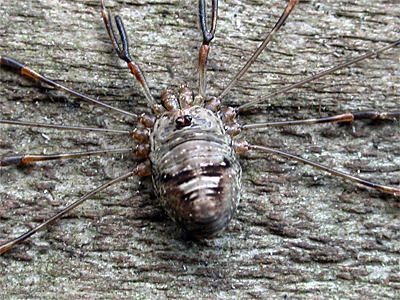 |
|
| ... | ||
| Dicranopalpus caudatus has quickly been confirmed from a number of UK sites to as far north as Yorkshire (Richards, P.), which means that Dicranopalpus ramosus specimens should ideally be checked to rule out the possibility of D. caudatus. There can really be no doubt that D. caudatus is already in Nottinghamshire and has been for many years. | ||
|
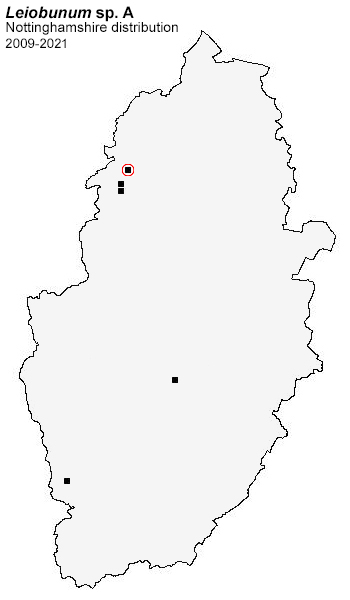 |
||||||
| ... | |||||||
|
The first records from other European countries were Germany and Austria (2006) Switzerland (2007) and France in 2009, matching the UK's first. It is believed that this Harvestman arrived in Europe via importation. Efforts by Wijnhoven, Schönhofer & Martens to contact several specialists, saw them concentrate on Spain and Northern Africa, and then Mexico and the southern parts of the United States, in order to determine it's origin. All their efforts have still (so far) drawn a blank some 16 years on. First Nottinghamshire records: Nottinghamshire's first was found on the wall of a house on Ridgeway, situated off Gloucester Road in Worksop which remained the only record until it was found in Barnsley on 22/09/12 (Richards, P.). This inspired a renewed series of surveys and three years to the very day of our initial record, we located Leiobunum sp.A, on the walls of Worksop Priory on 13/10/12. Worksop Priory remained the only site to see this impressively leggy Harvestman until a male was found at Oxton on 30/07/18 (Heeney, W.) and on a Bramcote house on 23/07/19 (Campbell, J.). |
|
|
An Leiobunum sp.A aggregation was found under an archway on Bridge Street in the middle of Worksop on 12/09/20 (Michalek, L.), about a quarter of a mile from Worksop Priory. Habitat: Has only been recorded from urban locations, on the walls of houses, industrial buildings and churches. Leiobunum sp.A is known to accumulate in large groups known as aggregations. These can contain up to a thousand individuals, but the largest found at Worksop contained approximately 130 out of a site total of 308 on 13/08/16. Our own studies from Worksop Priory, show that Leiobunum sp.A aggregations of different generations (now the ninth at Worksop) form in the exactly the same spots each year and are always underneath architectural arches, overhangs, or behind drainpipes. Latest known distribution (to March 2021): Now known from five Nottinghamshire locations. Three of these are located in Worksop, but there are records from a garden centre at Oxton and from a house at Bramcote. It is definitely elsewhere in Nottinghamshire. |
|
Latest known distribution (to March 2021): Now known from five Nottinghamshire locations. Three of these are located in Worksop, but there are records from a garden centre at Oxton and from a house at Bramcote. It is definitely elsewhere in Nottinghamshire. Adult season: Adults occur from the end of June until late December, but juveniles and sub-adults can be found from early June onwards. Identification: Pure overall size and leg length alone makes this an easy species to ID. Although there is the similar Liobunum gracile in parts of northern Scotland and the likelihood of other Liobunum species turning up in the UK through accidental importation. Confusion between both Leiobunum rotundum and Leiobunum blackwalli is unlikely as Leiobunum sp.A is considerably larger. |
| Pages in this series |
|
|
| Recent invertebrate arrivals and colonisers No 1 (larger bugs) |
| Recent invertebrate arrivals and colonisers No 2 (leaf miners) |
| Recent invertebrate arrivals and colonisers No 3 (Harvestmen) |
| Recent invertebrate arrivals and colonisers No 4 (larger moths) |
|
|
| Spiders |
| Homepage |